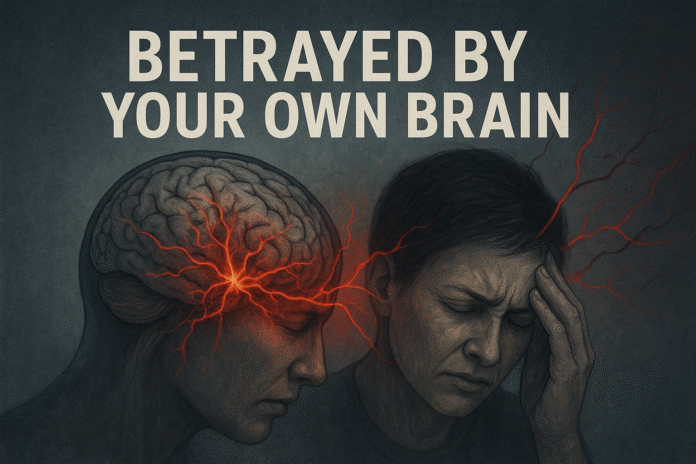Understanding the Migraine Brain and the Science Behind Pain
You are thinking of a normal day as you begin to walk down the hall, the sun floods the room with its sunlight, there is a faint buzz of people talking to each other, and you can smell the coffee that is freshly brewing in the kitchen. Then out of nowhere, it feels as if your mind begins to fight back. The light gets too intense for you, the softest of noises is a boom now, and even the slightest movement sends pains throughout your entire skull. This isn’t just a headache; it is the beginning of a migraine, a neurological episode in a downpour of a storm.
In the eyes of psychology and neuroscience, an individual that suffers from migraine episodes is suffering from more than a simple headache. It is a full-blown neurological disorder. The migraine mechanisms of the brain and the rest of the nervous system as a whole become hypersensitive to light, sound, stress, or specific types of food. This phenomenon, called a migraine ‘attack’, shifts the equilibrium of the brain’s relative calm. It causes pain and the erotic spasm to become hyperfunctioning. Blood vessels dilate further while the balancing functions of neurotransmitters, the serotonin and dopamine, swing out of balance, resulting to the chaos. The brain bolts along a disturbed sociability network. And the outcome is not just pain, it is the aggravated pain along with the uncontrollable nausea, a feeling of motion sickness, the ability to faint and faint for a couple of days in a row.
Reflexive Response of a Migraine Sufferer and the Migraine Brain’s Overreaction
From a biological perspective, the migraine brain functions differently from most brains. Picture having a brain that is wired like a sophisticated alarm system that keeps you safe. For those who suffer from migraines, that system is alarmed and ready, perpetually set to scream at the slightest provocation. Things like a flickering light, a meal that was skipped, or a stressful meeting, common triggers for migraines, can set off a domain of neural catastrophes that activate the trigeminal nerve, which then releases inflammatory agents that foster the dilation and constriction of blood vessels. It is the interplay of these nerves and vessels which is at the very heart of migraine pain.
Recent imaging studies reveal that migraineurs often show heightened activity in the brainstem and thalamus, which in most other people function to filter sensory input. In other words, their brains filter out stimuli poorly; instead, they magnify every single bit of it. The brain, in its most primal form, perceives itself to be under siege, and will send out pain signals and restrictions – the phenotypic representation of someone who has a brain prone to migraines.
When Life Experience Shapes the Migraine Brain
Many people suffer from migraines and see them as solely biological. For people like this, a migraine can also act as a form of psychological conditioning. In a hypervigilant world, children who grow in pressure or emotionally unfavorable situations develop very different, often disordered, nervous systems. The brain stays in the primed position throughout adulthood and is perpetually poised to be on the lookout, which further increases susceptibility to migraines. Psychologists note that migraines come with a heavy emotional burden. Their unpredictability can cause anxiety, and having to retreat to a dark room can ignite anger and self-loathing. Through another person’s lens, it can seem as if someone is “simply sensitive,” but in reality, that person’s migraine brain is waging an invisible war. Migraines are not a sign of weakness; they are a warning from the body’s internal system that it is time to shut down due to an overwhelmed and overactive nervous system.
A Day in the Life of Sarah and the Reality of Living with a Migraine Brain
Consider marketing executive Sarah, 35, with a key presentation to deliver that morning. She recalls witnessing lines and flashes of light in her visual field, a Crescent Moon phenomenon, only to grow more illuminated. She recognizes the signs and the pain a piercing sensation that starts only on one side of the skull and worsens gradually starts. Her cognitive functions begin to breakdown and the feeling of nausea forms a vicious cycle. She finds herself in a meeting alongside her coworkers when her attention shifts to a room/space that remains dark and quiet. Unlike her, the rest of the people in the room seem to carry on with the meeting. For the next few days, all that is left of her is an exhausted self, and that is also how her colleagues perceive her. Other people have a hard time grasping and understand what it means to live with a migraine brain. It is unpredictable, it is isolating and it is profound.
The Pain Sensitivity and Genetic Link of the Migraine Brain
Pain is a complex phenomenon to understand it completely, even so when it is about the migraine. Genetics holds a crucial role in deciding which individuals are more prone or susceptible to it. Some genes increase the excitability of certain brains more than others. In the case of a parent having migraines, the children are at a 2X risk which is puzzling between them. Families like to call them the migraine legacy.
Families develop the capacity to empathize as it is the only choice of survival. Witnessing someone you love going through the same suffering is a source of terror and so is the recognition that migraines while painful indicates the failure of the brain’s protective attributes.
Modifying and Controlling the Migraine Brain Through Balance and Awareness
The new research is more focused on attempting to train the nervous system rather than the pain suppression. Pain relief should always be the last of the steps. Stress reduction, sleep, and targeted medications might help in regaining equilibrium. This is contrary to the concept that caffeine and missed meals cause dehydration. Proper hydration is essential as well.
It is with this understanding that migraine brain sufferers can switch from suffering to actively managing the pain when the understanding is there. The pain is a system that longs to be in balance and supportive to be reset.
I’ve learned to treat my migraines not as a punishment, but as dare: a test I must endure in order to unravel the exquisite tale sieved through each thread of agony.



